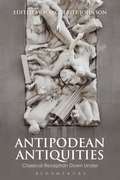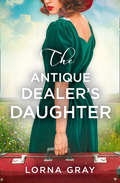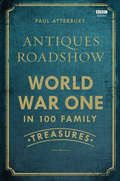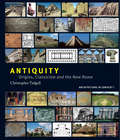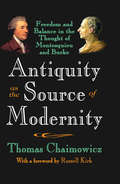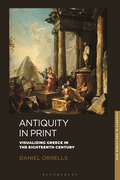- Table View
- List View
Antioch: A History (Cities of the Ancient World)
by Andrea U. De Giorgi A. Asa EgerThis is a complete history of Antioch, one of the most significant major cities of the eastern Mediterranean and a crossroads for the Silk Road, from its foundation by the Seleucids, through Roman rule, the rise of Christianity, Islamic and Byzantine conquests, to the Crusades and beyond. Antioch has typically been treated as a city whose classical glory faded permanently amid a series of natural disasters and foreign invasions in the sixth and seventh centuries CE. Such studies have obstructed the view of Antioch’s fascinating urban transformations from classical to medieval to modern city and the processes behind these transformations. Through its comprehensive blend of textual sources and new archaeological data reanalyzed from Princeton’s 1930s excavations and recent discoveries, this book offers unprecedented insights into the complete history of Antioch, recreating the lives of the people who lived in it and focusing on the factors that affected them during the evolution of its remarkable cityscape. While Antioch’s built environment is central, the book also utilizes landscape archaeological work to consider the city in relation to its hinterland, and numismatic evidence to explore its economics. The outmoded portrait of Antioch as a sadly perished classical city par excellence gives way to one in which it shines as brightly in its medieval Islamic, Byzantine, and Crusader incarnations. Antioch: A History offers a new portal to researching this long-lasting city and is also suitable for a wide variety of teaching needs, both undergraduate and graduate, in the fields of classics, history, urban studies, archaeology, Silk Road studies, and Near Eastern/Middle Eastern studies. Just as importantly, its clarity makes it attractive for, and accessible to, a general readership outside the framework of formal instruction.
Antioch: A History (Cities of the Ancient World)
by Andrea U. De Giorgi A. Asa EgerThis is a complete history of Antioch, one of the most significant major cities of the eastern Mediterranean and a crossroads for the Silk Road, from its foundation by the Seleucids, through Roman rule, the rise of Christianity, Islamic and Byzantine conquests, to the Crusades and beyond. Antioch has typically been treated as a city whose classical glory faded permanently amid a series of natural disasters and foreign invasions in the sixth and seventh centuries CE. Such studies have obstructed the view of Antioch’s fascinating urban transformations from classical to medieval to modern city and the processes behind these transformations. Through its comprehensive blend of textual sources and new archaeological data reanalyzed from Princeton’s 1930s excavations and recent discoveries, this book offers unprecedented insights into the complete history of Antioch, recreating the lives of the people who lived in it and focusing on the factors that affected them during the evolution of its remarkable cityscape. While Antioch’s built environment is central, the book also utilizes landscape archaeological work to consider the city in relation to its hinterland, and numismatic evidence to explore its economics. The outmoded portrait of Antioch as a sadly perished classical city par excellence gives way to one in which it shines as brightly in its medieval Islamic, Byzantine, and Crusader incarnations. Antioch: A History offers a new portal to researching this long-lasting city and is also suitable for a wide variety of teaching needs, both undergraduate and graduate, in the fields of classics, history, urban studies, archaeology, Silk Road studies, and Near Eastern/Middle Eastern studies. Just as importantly, its clarity makes it attractive for, and accessible to, a general readership outside the framework of formal instruction.
Antiphilosophy of Christianity
by Ghislain DeslandesThis text presents and addresses the philosophical movement of antiphilosophy working thru the texts of Christian thinkers such as Pascal and Kierkegaard. The author as influenced by Alain Badiou, portrays these Christian thinkers as of a subjective dimension negating the possibility of an objective quest for truth. The claim here is that antiphilosophy is abundant in the eyes of these two thinkers who frame the thought event as represented by Christianity, ultimately resigning itself to more or less the opposite of philosophy itself. Readers will discover why philosophical reason should never be convinced by that which denies its very authority.Subjecting faith to the perils of philosophical analysis, confronting the philosophical tradition with the truth of the Christian faith, and occupying the space between the two: such are the challenges facing an antiphilosophy of Christianity. This text will appeal to researchers and students working in continental philosophy, philosophy of religion and those in religious studies who want to investigate the links between Christianity and antiphilosophy.
Antipodean Antiquities: Classical Reception Down Under (Bloomsbury Studies in Classical Reception)
by Marguerite JohnsonLeading and emerging, early career scholars in Classical Reception Studies come together in this volume to explore the under-represented area of the Australasian Classical Tradition. They interrogate the interactions between Mediterranean Antiquity and the antipodean worlds of New Zealand and Australia through the lenses of literature, film, theatre and fine art.Of interest to scholars across the globe who research the influence of antiquity on modern literature, film, theatre and fine art, this volume fills a decisive gap in the literature by bringing antipodean research into the spotlight. Following a contextual introduction to the field, the six parts of the volume explore the latest research on subjects that range from the Lord of the Rings and Xena: Warrior Princess franchises to important artists such as Sidney Nolan and local authors whose work offers opportunities for cross-cultural and interdisciplinary analysis with well-known Western authors and artists.
Antipodean Antiquities: Classical Reception Down Under (Bloomsbury Studies in Classical Reception)
by Marguerite JohnsonLeading and emerging, early career scholars in Classical Reception Studies come together in this volume to explore the under-represented area of the Australasian Classical Tradition. They interrogate the interactions between Mediterranean Antiquity and the antipodean worlds of New Zealand and Australia through the lenses of literature, film, theatre and fine art.Of interest to scholars across the globe who research the influence of antiquity on modern literature, film, theatre and fine art, this volume fills a decisive gap in the literature by bringing antipodean research into the spotlight. Following a contextual introduction to the field, the six parts of the volume explore the latest research on subjects that range from the Lord of the Rings and Xena: Warrior Princess franchises to important artists such as Sidney Nolan and local authors whose work offers opportunities for cross-cultural and interdisciplinary analysis with well-known Western authors and artists.
Antipodean George Eliot (The Nineteenth Century Series)
by Margaret Harris Matthew SussmanIn Middlemarch, George Eliot famously warns readers not to see themselves as the centre of their own world, which produces a ‘flattering illusion of concentric arrangement’. The scholarly contributors to Antipodean George Eliot resist this form of centrism. Hailing from four continents and six countries, they consider Eliot from a variety of de-centred vantage points, exploring how the obscure and marginal in Eliot’s life and work sheds surprising light on the central and familiar. With essays that span the full range of Eliot’s career—from her early journalism, to her major novels, to eccentric late works such as Impressions of Theophrastus Such—Antipodean George Eliot is committed to challenging orthodoxies about Eliot’s development as a writer, overturning received ideas about her moral and political thought, and unveiling new contexts for appreciating her unparalleled significance in nineteenth-century letters.
Antipodean George Eliot (The Nineteenth Century Series)
by Margaret Harris Matthew SussmanIn Middlemarch, George Eliot famously warns readers not to see themselves as the centre of their own world, which produces a ‘flattering illusion of concentric arrangement’. The scholarly contributors to Antipodean George Eliot resist this form of centrism. Hailing from four continents and six countries, they consider Eliot from a variety of de-centred vantage points, exploring how the obscure and marginal in Eliot’s life and work sheds surprising light on the central and familiar. With essays that span the full range of Eliot’s career—from her early journalism, to her major novels, to eccentric late works such as Impressions of Theophrastus Such—Antipodean George Eliot is committed to challenging orthodoxies about Eliot’s development as a writer, overturning received ideas about her moral and political thought, and unveiling new contexts for appreciating her unparalleled significance in nineteenth-century letters.
Antiquarianism and Intellectual Life in Europe and China, 1500-1800 (The Bard Graduate Center Cultural Histories of the Material World)
by Peter N Miller Francois LouisThis book is a project in comparative history, but along two distinct axes, one historical and the other historiographical. Its purpose is to constructively juxtapose the early modern European and Chinese approaches to historical study that have been called "antiquarian." As an exercise in historical recovery, the essays in this volume amass new information about the range of antiquarian-type scholarship on the past, on nature, and on peoples undertaken at either end of the Eurasian landmass between 1500 and 1800. As a historiographical project, the book challenges the received---and often very much under conceptualized---use of the term "antiquarian" in both European and Chinese contexts. Readers will not only learn more about the range of European and Chinese scholarship on the past---and especially the material past---but they will also be able to integrate some of the historiographical observations and corrections into new ways of conceiving of the history of historical scholarship in Europe since the Renaissance, and to reflect on the impact of these European terms on Chinese approaches to the Chinese past. This comparison is a two-way street, with the European tradition clarified by knowledge of Chinese practices, and Chinese approaches better understood when placed alongside the European ones.
The Antiquary: John Aubrey's Historical Scholarship (Oxford English Monographs)
by Kelsey Jackson WilliamsJohn Aubrey (1626-1697), antiquary, natural philosopher, and virtuoso, is best-remembered today for his Brief Lives, biographies of his contemporaries filled with luminous detail which have been mined for anecdotes by generations of scholars. However, Aubrey was much more than merely the hand behind an invaluable source of biographical material; he was also the author of thousands of pages of manuscript notebooks covering everything from the origins of Stonehenge to the evolution of folklore. Kelsey Jackson Williams explores these manuscripts in full for the first time and in doing so illuminates the intricacies of Aubrey's investigations into Britain's past. The Antiquary is both a major new study of an important early modern writer and a significant intervention in the developing historiography of antiquarianism. It discusses the key aspects of Aubrey's work in a series of linked chapters on archaeology, architecture, biography, folklore, and philology, concluding with a revisionist interpretation of Aubrey's antiquarian writings. While covering a wide variety of scholarly territory, it remains rooted in the common thread of Aubrey's own intellectual development and the continual interaction between his texts as he studied, discovered, revised, and rewrote them across four decades. Its conclusions not only substantially reshape our understanding of Aubrey and his works, but also provide new understandings of the methodologies, ambitions, and achievements of antiquarianism across early modern Europe.
The Antiquary: John Aubrey's Historical Scholarship (Oxford English Monographs)
by Kelsey Jackson WilliamsJohn Aubrey (1626-1697), antiquary, natural philosopher, and virtuoso, is best-remembered today for his Brief Lives, biographies of his contemporaries filled with luminous detail which have been mined for anecdotes by generations of scholars. However, Aubrey was much more than merely the hand behind an invaluable source of biographical material; he was also the author of thousands of pages of manuscript notebooks covering everything from the origins of Stonehenge to the evolution of folklore. Kelsey Jackson Williams explores these manuscripts in full for the first time and in doing so illuminates the intricacies of Aubrey's investigations into Britain's past. The Antiquary is both a major new study of an important early modern writer and a significant intervention in the developing historiography of antiquarianism. It discusses the key aspects of Aubrey's work in a series of linked chapters on archaeology, architecture, biography, folklore, and philology, concluding with a revisionist interpretation of Aubrey's antiquarian writings. While covering a wide variety of scholarly territory, it remains rooted in the common thread of Aubrey's own intellectual development and the continual interaction between his texts as he studied, discovered, revised, and rewrote them across four decades. Its conclusions not only substantially reshape our understanding of Aubrey and his works, but also provide new understandings of the methodologies, ambitions, and achievements of antiquarianism across early modern Europe.
The Antique Dealer’s Daughter
by Lorna Gray‘An original, authentic period mystery that keeps you guessing, with a strong female protagonist’ Jane Hunt Book Reviews
Antiques Roadshow: World War One In 100 Family Treasures
by Paul AtterburyTo mark the centenary of the start of World War I, the Antiques Roadshow team filmed a series of specials at the Somme, where the public brought in their family's war memorabilia and photographs. These 'antiques' weren't financially valuable, or in some cases even very beautiful, but the stories that came attached to these momentoes were priceless. Antiques Roadshow: World War I in 100 Family Treasures takes 100 of the most fascinating and moving stories and shows how they fit in to the wider history that was occuring around them. From Rifleman Frank Edwards, who led the 'big push' in September 1915 kicking a football in front of the troops (and survived to tell the tale) to the formidable Catherine Murray Roy, one of the first 50 nurses to be sent to the front lines in France. The story behind each object paints an intimate portrait of a long-lost relative, and quotes from the modern-day participants in the roadshow provide a moving link between the families then and now. Fully illustrated, and featuring all the stories from the show, this is a truly unique way of telling the story of those ordinary lives that were, by the onset of war in 1914, thrown into the most extraordinary of circumstances.
Antiquity: Greeks and Romans in Context
by Frederick G. Naerebout Henk W. SingorAntiquity: Greeks and Romans in Context provides a chronological introduction to the history of ancient Mediterranean civilizations within the larger context of its contemporary Eurasian world. Innovative approach organizes Greek and Roman history into a single chronology Combines the traditional historical story with subjects that are central to modern research into the ancient world including a range of social, cultural, and political topics Facilitates an understanding of the ancient Mediterranean world as a unity, just as the Mediterranean world is in its turn presented as part of a larger whole Covers the entire ancient Mediterranean world from pre-history through to the rise of Islam in the seventh century A.D. Features a diverse collection of images, maps, diagrams, tables, and a chronological chart to aid comprehension English translation of a well-known Dutch book, De oudheid, now in its third edition
Antiquity: Greeks and Romans in Context
by Frederick G. Naerebout Henk W. SingorAntiquity: Greeks and Romans in Context provides a chronological introduction to the history of ancient Mediterranean civilizations within the larger context of its contemporary Eurasian world. Innovative approach organizes Greek and Roman history into a single chronology Combines the traditional historical story with subjects that are central to modern research into the ancient world including a range of social, cultural, and political topics Facilitates an understanding of the ancient Mediterranean world as a unity, just as the Mediterranean world is in its turn presented as part of a larger whole Covers the entire ancient Mediterranean world from pre-history through to the rise of Islam in the seventh century A.D. Features a diverse collection of images, maps, diagrams, tables, and a chronological chart to aid comprehension English translation of a well-known Dutch book, De oudheid, now in its third edition
Antiquity: Origins, Classicism and The New Rome
by Christopher TadgellThe first in a new series of five books describing and illustrating the seminal architectural traditions of the world, Antiquity traces architectural history from its very beginnings until the time when the traditions that shape today’s environments began to flourish. More than a catalogue of buildings, in this work Tadgell provides their political, technological, social and cultural contexts and explores architecture, not only as the development of form and space but as an expression of the civilization within which it evolves. The buildings are analyzed and illustrated with over 1200 colour photographs and 400 drawings while the societies that produced them are brought to life through a broad selection of their artefacts.
Antiquity: Origins, Classicism and The New Rome
by Christopher TadgellThe first in a new series of five books describing and illustrating the seminal architectural traditions of the world, Antiquity traces architectural history from its very beginnings until the time when the traditions that shape today’s environments began to flourish. More than a catalogue of buildings, in this work Tadgell provides their political, technological, social and cultural contexts and explores architecture, not only as the development of form and space but as an expression of the civilization within which it evolves. The buildings are analyzed and illustrated with over 1200 colour photographs and 400 drawings while the societies that produced them are brought to life through a broad selection of their artefacts.
Antiquity and the Meanings of Time: A Philosophy of Ancient and Modern Literature (New Directions in Classics #Vol. 1)
by Duncan F. KennedySociety and contemporary culture are forever fascinated by the topic of time. In modern fiction, Ian McEwan (The Child in Time) and Martin Amis (Time's Arrow) have led the way in exploring the human condition in relation to past, present and future. In cinema, several recent cultural texts (Memento, Minority Report, The Hours) have similarly reflected a preoccupation with temporality and human experience. And in the sphere of politics, debates about the 'end of history', led by Francis Fukuyama, indicate that how we live is deeply determined by our relationship not only to place but also to the passing of time. In his major new work, Duncan F Kennedy takes up this abiding preoccupation and offers a nuanced reading of theories of time in relation to many of the most important writers of classical and late antiquity. He discusses a number of key texts (Homer's Odyssey; Sophocles' Oedipus Rex; Virgil's Aeneid; Ovid's Metamophoses; and the Confessions of Augustine) and imaginatively sets these side-by-side with modern works (such as Sterne's Tristram Shandy; Joyce's Ulysses; Orwell's Nineteen Eighty-Four; and Primo Levi's The Drowned and the Saved). His intention is to show that, from era to era, whether 'ancient' or 'modern', human beings have in different ways tried to articulate a coherent understanding of the process of history and of their place within it. Discussing with precision and clarity complex ideas relating to deconstruction, reception studies and psychoanalytical criticism, Kennedy's book represents a daring attempt to formulate a comparative cross-disciplinary philosophy of time in its own right, which will have considerable appeal to students and scholars not just in classics but in the humanities more broadly, as well as beyond.
Antiquity as the Source of Modernity: Freedom and Balance in the Thought of Montesquieu and Burke
by Thomas ChaimowiczThis is a book that contrary to common practice, shows the commonalities of ancient and modern theories of freedom, law, and rational actions. Studying the works of the ancients is necessary to understanding those that follow. Thomas Chaimowicz challenges current trends in research on antiquity in his examination of Montesquieu's and Burk's path of inquiry. He focuses on ideas of balance and freedom. Montesquieu and Burke believe that freedom and balance are closely connected, for without balance within a state there can be no freedom.When Montesquieu speaks of republics, he means those of antiquity as they were understood in the eighteenth century. In this view, freedom can develop only within the framework of established tradition. Edmund Burke's greatest service to political thought may lie in making use of this idea when he fought against the abstractions of the French Revolutionaries. Antiquity as the Source of Modernity examines Montesquieu's Roman mind, meaning not an attitude influenced by the ancients, but one primarily influenced by Roman heritage. It speaks to the antithesis of monarchy and despotism in Montesquieu's thought and the influence of Tacitus and Pliny the Younger on him. The separation of powers and its relation to the concept of the mixed constitution as well as Montesquieu's smaller masterpiece Considerations on the Causes of the Grandeur and Decadence of the Romans are examined in detail. Finally, the discussion leads seamlessly to Burke, who, as a critical admirer of Montesquieu, partly incorporated his interpretation of the English constitution into his own thinking threatened by teachings of the French Revolution and its British adherents.The central idea of Antiquity as the Source of Modernity is timeless. It is that the ancient past can lead to a clearer understanding of what follows. This perspective represents a reversal of the conventional procedures for conducting this kind of research,
Antiquity as the Source of Modernity: Freedom and Balance in the Thought of Montesquieu and Burke
by Thomas ChaimowiczThis is a book that contrary to common practice, shows the commonalities of ancient and modern theories of freedom, law, and rational actions. Studying the works of the ancients is necessary to understanding those that follow. Thomas Chaimowicz challenges current trends in research on antiquity in his examination of Montesquieu's and Burk's path of inquiry. He focuses on ideas of balance and freedom. Montesquieu and Burke believe that freedom and balance are closely connected, for without balance within a state there can be no freedom.When Montesquieu speaks of republics, he means those of antiquity as they were understood in the eighteenth century. In this view, freedom can develop only within the framework of established tradition. Edmund Burke's greatest service to political thought may lie in making use of this idea when he fought against the abstractions of the French Revolutionaries. Antiquity as the Source of Modernity examines Montesquieu's Roman mind, meaning not an attitude influenced by the ancients, but one primarily influenced by Roman heritage. It speaks to the antithesis of monarchy and despotism in Montesquieu's thought and the influence of Tacitus and Pliny the Younger on him. The separation of powers and its relation to the concept of the mixed constitution as well as Montesquieu's smaller masterpiece Considerations on the Causes of the Grandeur and Decadence of the Romans are examined in detail. Finally, the discussion leads seamlessly to Burke, who, as a critical admirer of Montesquieu, partly incorporated his interpretation of the English constitution into his own thinking threatened by teachings of the French Revolution and its British adherents.The central idea of Antiquity as the Source of Modernity is timeless. It is that the ancient past can lead to a clearer understanding of what follows. This perspective represents a reversal of the conventional procedures for conducting this kind of research,
Antiquity Forgot: Essays on Shakespeare, Bacon and Rembrandt (International Archives of the History of Ideas Archives internationales d'histoire des idées #90)
by Howard B. WhiteIt was probably Rousseau who first thought of dreams as ennobling experiences. Anyone who has ever read Reveries du Promeneur Solitaire must be struck by the dreamlike quality of Rousseau's meditations. This dreamlike quality is still with us, and those who experience it find themselves ennobled by it. Witness Martin Luther King's famous "1 have a dream. " Dreaming and inspiration raise the artist to the top rung in the ladder ofhuman relations. That is probably the prevailing view among educated people of our time. Rousseau made that view respectable and predominant. Yet in another sense, the problem is much older. It is the problem of political philosophy and poetry, the problem of Socrates and Aristophanes, of Plato and Homer. Yet, while antiquity usually gives the crown to philosophy, since Rous seau, the alternative view tends to prevail. The distinction is not, however, a formal one. Sir Philip Sidney enlisted Plato on the side of poetry. The true distinction is between imagination and reason. If reason is to rule, as Aristotle points out,l the most architectonic of the sciences, that is political science, should rule. It is political philosophy which must determine the nature of the arts which will help or which will hinder the good of the city or the polity. That does not mean that a mere professor should stand in judgment of Shake speare, Bacon, and Rembrandt. It means that ifhe studies these three great artists, he is not over-stepping disciplinary limits.
Antiquity Imagined: The Remarkable Legacy of Egypt and the Ancient Near East
by Robin DerricourtOutsiders have long attributed to the Middle East, and especially to ancient Egypt, meanings that go way beyond the rational and observable. The region has been seen as the source of civilization, religion, the sciences and the arts; but also of mystical knowledge and outlandish theories, whether about the Lost City of Atlantis or visits by alien beings. In his exploration of how its past has been creatively interpreted by later ages, Robin Derricourt surveys the various claims that have been made for Egypt - particularly the idea that it harbours an esoteric wisdom vital to the world's survival. He looks at 'alternative' interpretations of the pyramids, from maps of space and time to landing markers for UFOs; at images of the Egyptian mummy and at the popular mythology of the 'pharaoh's curse'; and at imperialist ideas of racial superiority that credited Egypt with spreading innovations and inventions as far as the Americas, Australia and China. Including arcane ideas about the Lost Ten Tribes of biblical Israel, the author enlarges his focus to include the Levant.His book is the first to show in depth how ancient Egypt and the surrounding lands have so continuously and seductively tantalised the Western imagination.
Antiquity Imagined: The Remarkable Legacy of Egypt and the Ancient Near East
by Robin DerricourtOutsiders have long attributed to the Middle East, and especially to ancient Egypt, meanings that go way beyond the rational and observable. The region has been seen as the source of civilization, religion, the sciences and the arts; but also of mystical knowledge and outlandish theories, whether about the Lost City of Atlantis or visits by alien beings. In his exploration of how its past has been creatively interpreted by later ages, Robin Derricourt surveys the various claims that have been made for Egypt - particularly the idea that it harbours an esoteric wisdom vital to the world's survival. He looks at 'alternative' interpretations of the pyramids, from maps of space and time to landing markers for UFOs; at images of the Egyptian mummy and at the popular mythology of the 'pharaoh's curse'; and at imperialist ideas of racial superiority that credited Egypt with spreading innovations and inventions as far as the Americas, Australia and China. Including arcane ideas about the Lost Ten Tribes of biblical Israel, the author enlarges his focus to include the Levant. His book is the first to show in depth how ancient Egypt and the surrounding lands have so continuously and seductively tantalised the Western imagination.
Antiquity in Print: Visualizing Greece in the Eighteenth Century (New Directions in Classics)
by Daniel OrrellsDaniel Orrells examines the ways in which the ancient world was visualized for Enlightenment readers, and reveals how antiquarian scholarship emerged as the principal technology for envisioning ancient Greek culture, at a time when very few people could travel to Greece which was still part of the Ottoman Empire. Offering a fresh account of the rise of antiquarianism in the 18th century, Orrells shows how this period of cultural progression was important for the invention of classical studies. In particular, the main focus of this book is on the visionary experimentalism of antiquarian book production, especially in relation to the contentious nature of ancient texts. With the explosion of the Quarrel between the Ancients and the Moderns, eighteenth-century intellectuals, antiquarians and artists such as Giambattista Vico, Johann Joachim Winckelmann, the Comte de Caylus, James Stuart, Julien-David Leroy, Giovanni Battista Piranesi and Pierre-François Hugues d'Hancarville all became interested in how printed engravings of ancient art and archaeology could visualize a historical narrative. These figures theorized the relationship between ancient text and ancient material and visual culture - theorizations which would pave the way to foundational questions at the heart of the discipline of classical studies and neoclassical aesthetics.
Antiquity in Print: Visualizing Greece in the Eighteenth Century (New Directions in Classics)
by Daniel OrrellsDaniel Orrells examines the ways in which the ancient world was visualized for Enlightenment readers, and reveals how antiquarian scholarship emerged as the principal technology for envisioning ancient Greek culture, at a time when very few people could travel to Greece which was still part of the Ottoman Empire. Offering a fresh account of the rise of antiquarianism in the 18th century, Orrells shows how this period of cultural progression was important for the invention of classical studies. In particular, the main focus of this book is on the visionary experimentalism of antiquarian book production, especially in relation to the contentious nature of ancient texts. With the explosion of the Quarrel between the Ancients and the Moderns, eighteenth-century intellectuals, antiquarians and artists such as Giambattista Vico, Johann Joachim Winckelmann, the Comte de Caylus, James Stuart, Julien-David Leroy, Giovanni Battista Piranesi and Pierre-François Hugues d'Hancarville all became interested in how printed engravings of ancient art and archaeology could visualize a historical narrative. These figures theorized the relationship between ancient text and ancient material and visual culture - theorizations which would pave the way to foundational questions at the heart of the discipline of classical studies and neoclassical aesthetics.


